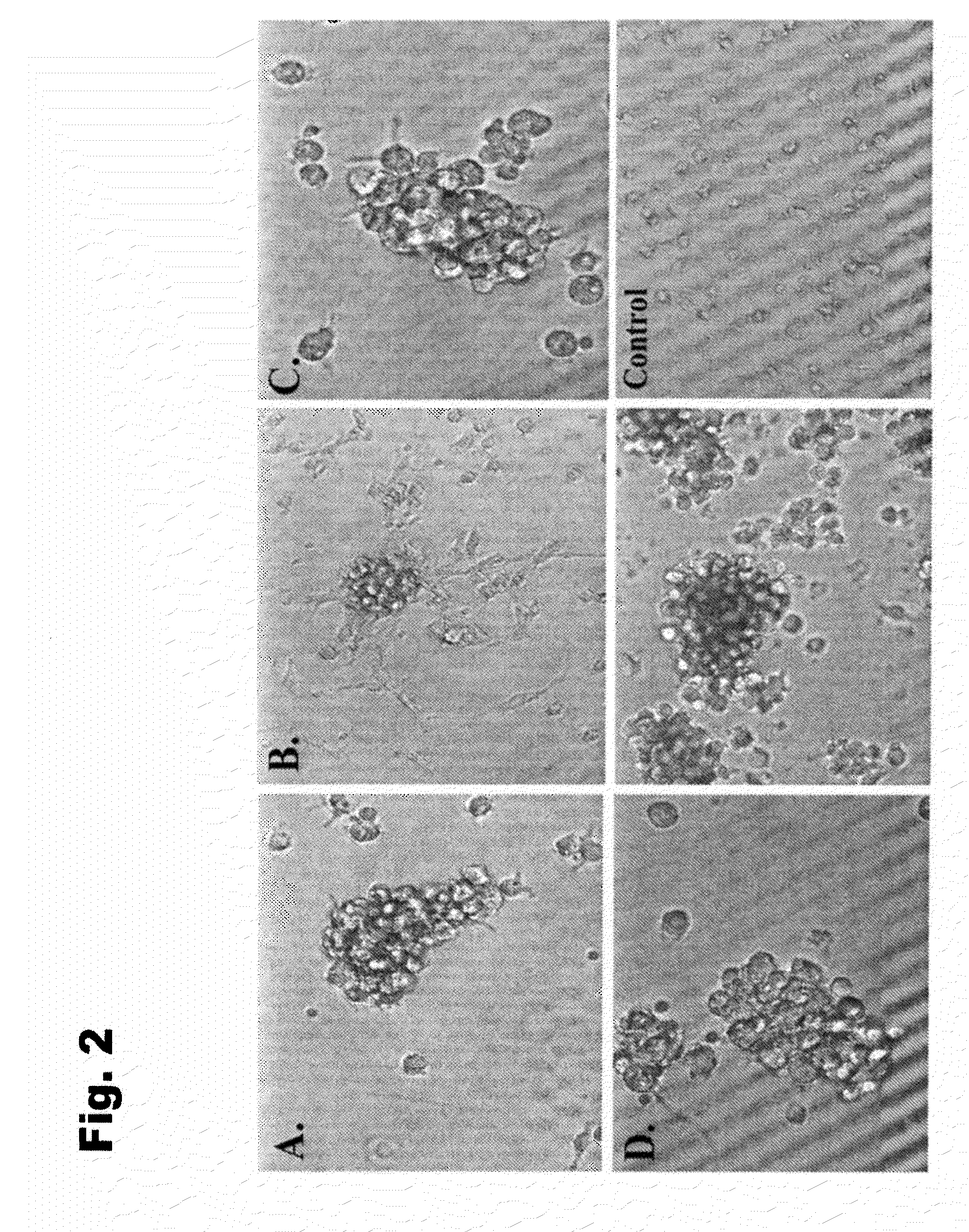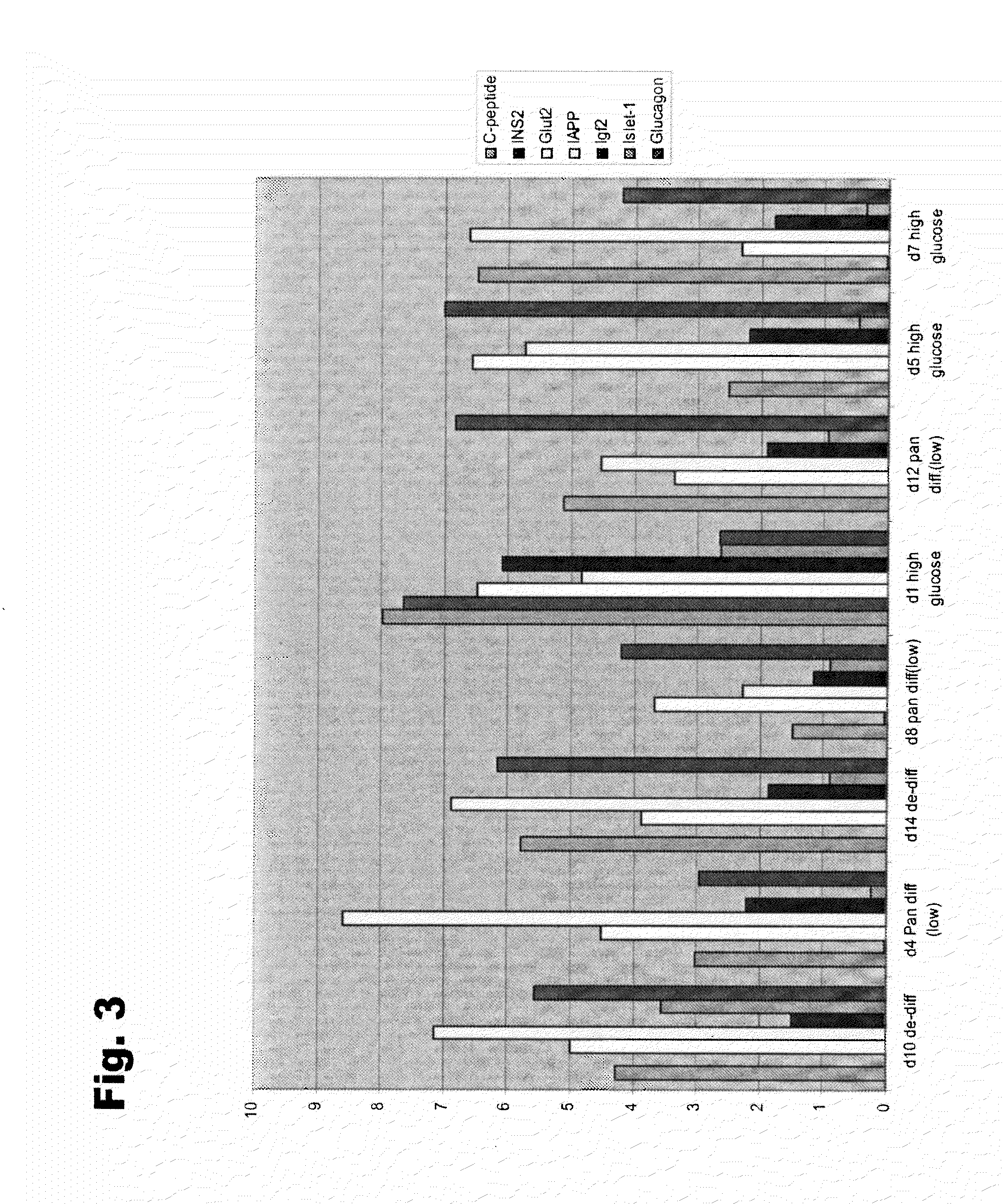Pancreatic islet-like cells
a technology of pancreatic islet and composition, applied in the field of generating pancreatic isletlike cells, can solve the problems of increasing blood glucose levels, complex and poorly understood, and failing to generate enough insulin to maintain normal homeostasis
- Summary
- Abstract
- Description
- Claims
- Application Information
AI Technical Summary
Problems solved by technology
Method used
Image
Examples
example 1
Differentiation of MDIs
[0047]Isolated peripheral blood monocytes were plated in a 2:1 mixture of Megacell DMEM / F12 medium (Cat. No. M4192, Sigma-Aldrich) and AIM V medium (Invitrogen) and cultured overnight at 37° C. and 5% CO2. The culture medium was supplemented with 4 mM L-glutamine and penicillin-streptomyocin. The cells were plated on FALCON vacuum-gas plasma treated plates. After 24 hours, the culture medium was removed and the cells were gently washed three times with 1× HBSS containing 2 mM EDTA. De-differentiation medium, which was Megacell DMEM / F12 or LDMEM (low glucose DMEM) or HDMEM (high glucose DMEM) containing 10 ng / ml leukocyte inhibitory factor (LIF; Cat. No. LIF1010, Chemicon) and 25 ng / ml macrophage colony-stimulating factor (M-CSF: Cat. No. GF053, Chemicon), was added. After three days, the medium was removed and replaced with fresh de-differentiation medium. After 6 days in culture the cells had de-differentiated into monocyte-derived stem cells (MDSCs).
[0048]MD...
example 2
Pancreatic Gene Expression
[0051]To monitor the differentiation of MDSCs into MDIs, the expression of pancreatic-specific genes was analyzed by real time PCR. The following cell-specific markers were examined: β-cell specific markers were Glut2, IAPP, Igf2, insulin, ngn3, and PDX1; α-cell specific marker, glucagon; and δ-cell specific marker, somatostatin. MDSCs were generated as described in Example 1. One set of MDSCs was maintained in de-differentiation medium. The second set was cultured in pancreatic differentiation medium for six days and then challenged with high glucose conditions.
[0052]For each time point, cells were collected (1×105 to 3×106 cells / well) and RNA was isolated using Qiagen Rneasy Kit (Cat. No. 74103) following the manufacturer's instructions. First strand cDNA was synthesized by mixing 1 ng-5 μg of RNA with 1 of 500 μg / ml of oligo(dT) (Invitrogen; catalog number 55063), 1 μl of 10 mM dNTPs (Invitrogen; catalog number 18427-013), and water to equal 12 μl. The m...
example 3
Insulin Secretion
[0055]To assess the functionality of the differentiated MDIs, insulin secretion was measured under the different conditions using an ELISA kit (Diagnostic Systems Labs Inc; Cat. No. DSL-10-1600). For this “one-step” sandwich-type Immunoassay, standards, controls, and unknown serum samples were incubated with an HRP-labeled anti-insulin antibody in microtitration wells that had been coated with another anti-insulin antibody. After incubation and washing, the wells were incubated with the substrate tetramethylbenzidine (TMB). An acidic stopping solution was then added and the degree of enzymatic turnover of the substrate was determined by dual wavelength absorbance measurement at 450 and 620 nm. The absorbance measured was directly proportional to the concentration of insulin present. A set of insulin standards was used to plot a standard curve of absorbance versus insulin concentration from which the concentration of insulin in the unknown samples was calculated.
[005...
PUM
| Property | Measurement | Unit |
|---|---|---|
| concentration | aaaaa | aaaaa |
| concentration | aaaaa | aaaaa |
| concentration | aaaaa | aaaaa |
Abstract
Description
Claims
Application Information
 Login to View More
Login to View More - R&D
- Intellectual Property
- Life Sciences
- Materials
- Tech Scout
- Unparalleled Data Quality
- Higher Quality Content
- 60% Fewer Hallucinations
Browse by: Latest US Patents, China's latest patents, Technical Efficacy Thesaurus, Application Domain, Technology Topic, Popular Technical Reports.
© 2025 PatSnap. All rights reserved.Legal|Privacy policy|Modern Slavery Act Transparency Statement|Sitemap|About US| Contact US: help@patsnap.com



